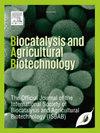膳食中的 7,10-二羟基-8(E)-十八碳烯酸可减少糖尿病/肥胖 KK-Ay 小鼠的脂肪积累,并预防高血糖和高脂血症
IF 3.4
Q2 BIOTECHNOLOGY & APPLIED MICROBIOLOGY
引用次数: 0
摘要
7,10-二羟基-8(E)-十八烯酸(DOD)是铜绿假单胞菌 PR3 从油酸中产生的一种二羟基脂肪酸。本研究调查了膳食 DOD 对糖尿病/肥胖 KK-Ay 小鼠肥胖、高脂血症和高血糖的预防作用。小鼠(5 周大)适应一周后,分为以下三组,分别喂食以 AIN-93G 为基础的高脂肪饮食(脂肪含量为 20%,重量百分比);对照组:3% 豆油 + 17% 猪油组,DOD 1% 组:3% 豆油 + 16% 猪油 +1% DOD,DOD 2% 组:3% 大豆油 + 15% 猪油 + 2% DOD。与对照组相比,饲喂1%和2% DOD日粮四周可抑制体重增加和内脏脂肪积累,改善血糖和血清脂质水平以及肝脏脂质积累。RT-PCR分析显示,脂肪连素(Adipoq)、促炎TNF-α(Tnfa)和MCP-1(Ccl2)的mRNA没有发生变化,但肠系膜白色脂肪组织(WAT)中瘦素mRNA的表达呈下降趋势,这表明DOD抑制脂肪积累有助于防止瘦素的过度产生。我们还观察到肝脏胰岛素靶糖原酶(如 PEPCK 和 G6Pase)和转录因子固醇调节元件结合蛋白-1 的 mRNA 表达减少。这些结果表明,膳食 DOD 能有效改善 KK-Ay 小鼠的葡萄糖和脂质代谢。本研究为二羟基脂肪酸作为功能性脂质的潜在用途提供了新的见解。本文章由计算机程序翻译,如有差异,请以英文原文为准。
Dietary 7,10-dihydroxy-8(E)-octadecenoic acid reduces fat accumulation and prevents hyperglycemia and hyperlipidemia in diabetic/obese KK-Ay mice
7,10-Dihydroxy-8(E)-octadecenoic acid (DOD) is a dihydroxy fatty acid produced by Pseudomonas aeruginosa PR3 from oleic acid. Present study investigated preventive effects of dietary DOD on obesity, hyperlipidemia and hyperglycemia in diabetic/obese KK-Ay mice. After one week of acclimation, mice (5-week-old) were divided three groups fed with AIN-93G-based high fat diet (20% fat, w/w) as follows; Control group: 3% soybean oil + 17% lard, DOD 1% group: 3% soybean oil + 16% lard +1% DOD, DOD 2% group: 3% soybean oil + 15% lard + 2% DOD. Four weeks feeding with 1% and 2% DOD diets suppressed body weight gain and visceral fat accumulation, and improved blood glucose and serum lipids levels as well as hepatic lipid accumulation compared to control group. RT-PCR analysis revealed no changes were observed in mRNA of adiponectin (Adipoq) and proinflammatory TNF-α (Tnfa) and MCP-1 (Ccl2), but a decreasing trend in leptin mRNA expression in mesenteric white adipose tissue (WAT), suggesting that suppressed fat accumulation by DOD contribute to prevention of over production of leptin. We also observed a reduction of mRNA expression of hepatic insulin-target gluconeogenic enzymes such as PEPCK and G6Pase and the transcription factor sterol regulatory element-binding protein-1. These results showed that dietary DOD is effective to improve glucose and lipid metabolism in KK-Ay mice. The present study provides new insights showing potential use of dihydroxy fatty acids as functional lipids.
求助全文
通过发布文献求助,成功后即可免费获取论文全文。
去求助
来源期刊

Biocatalysis and agricultural biotechnology
Agricultural and Biological Sciences-Agronomy and Crop Science
CiteScore
7.70
自引率
2.50%
发文量
308
审稿时长
48 days
期刊介绍:
Biocatalysis and Agricultural Biotechnology is the official journal of the International Society of Biocatalysis and Agricultural Biotechnology (ISBAB). The journal publishes high quality articles especially in the science and technology of biocatalysis, bioprocesses, agricultural biotechnology, biomedical biotechnology, and, if appropriate, from other related areas of biotechnology. The journal will publish peer-reviewed basic and applied research papers, authoritative reviews, and feature articles. The scope of the journal encompasses the research, industrial, and commercial aspects of biotechnology, including the areas of: biocatalysis; bioprocesses; food and agriculture; genetic engineering; molecular biology; healthcare and pharmaceuticals; biofuels; genomics; nanotechnology; environment and biodiversity; and bioremediation.
 求助内容:
求助内容: 应助结果提醒方式:
应助结果提醒方式:


